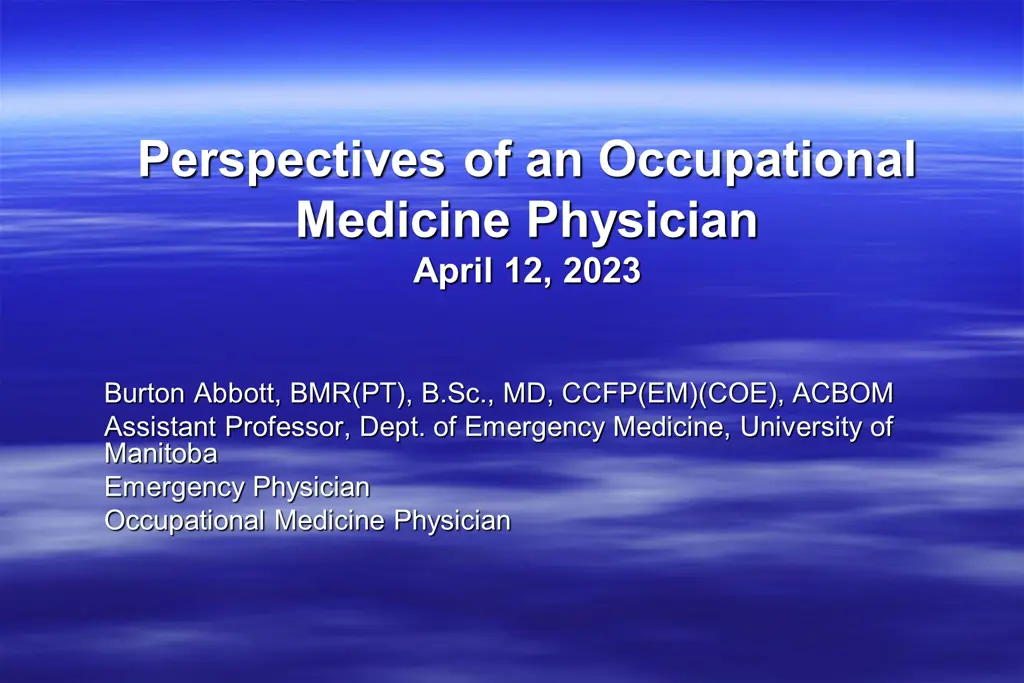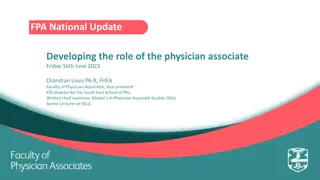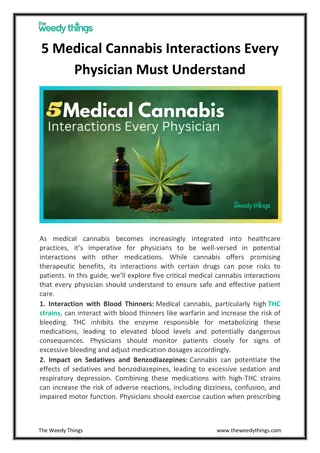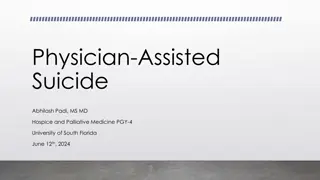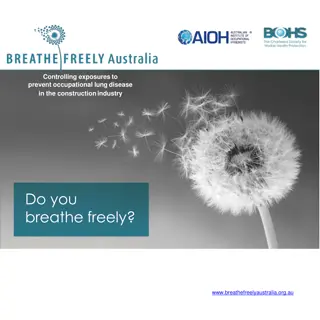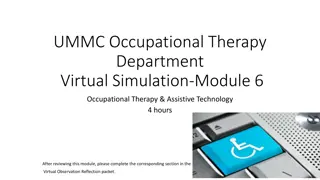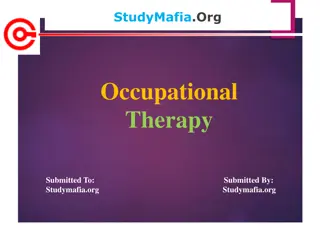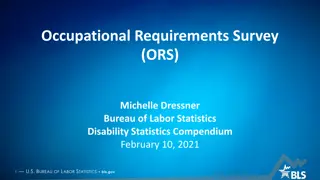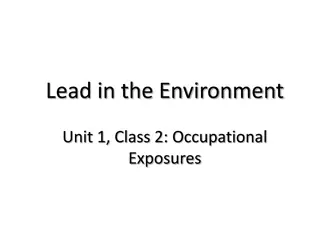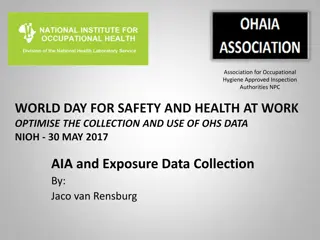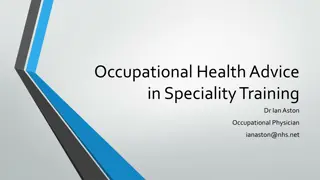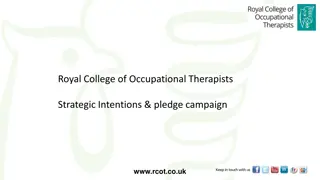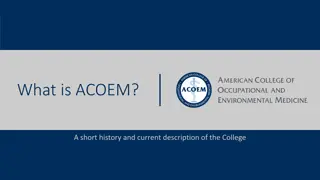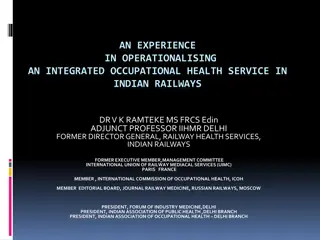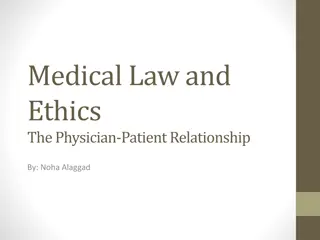Perspectives of an Occupational Medicine Physician
Gain insights from Dr. Burton Abbott, an Occupational Medicine Physician, as he discusses various topics related to work ability, caution when interpreting data, rehabilitation programs, and more.
Download Presentation

Please find below an Image/Link to download the presentation.
The content on the website is provided AS IS for your information and personal use only. It may not be sold, licensed, or shared on other websites without obtaining consent from the author.If you encounter any issues during the download, it is possible that the publisher has removed the file from their server.
You are allowed to download the files provided on this website for personal or commercial use, subject to the condition that they are used lawfully. All files are the property of their respective owners.
The content on the website is provided AS IS for your information and personal use only. It may not be sold, licensed, or shared on other websites without obtaining consent from the author.
E N D
Presentation Transcript
Perspectives of an Occupational Medicine Physician April 12, 2023 Burton Abbott, BMR(PT), B.Sc., MD, CCFP(EM)(COE), ACBOM Assistant Professor, Dept. of Emergency Medicine, University of Manitoba Emergency Physician Occupational Medicine Physician
Disclosure Over the years, I have been remunerated by: Manitoba Health (and WRHA, IERHA, SH, PMH) Manitoba Public Insurance Workers Compensation Board of MB Medical Services Plan of BC Insurance Corporation of BC University of Manitoba Pure Lifestyle Inc.
Disclosure Opinions presented are solely mine. Opinions expressed today do not represent the views of any organization with whom I am affiliated or have been affiliated. None of the organizations with whom I am affiliated or have been affiliated have remunerated me for today s presentation or its preparation. I am not trying to sell you any product or service today.
Outline Commenting on Ability to Work Caution When Data is Presented Blackbox Warning What Am I Looking for in a Rehabilitation Program?
One Item to Ponder Although we have different perspectives and there may differences of opinion, everybody has one goal in common: All parties want an individual affected by illness or injury to have highest possible level of function and best quality of life.
Can Mr. Smith Return to Work The parameters to consider when commenting on ability to return to a work place are: Risk Capacity Tolerance
Risk The probability of harm to the individual, co- workers or members of society that occurs with a return to the activity in question. Depends on the condition and the job Seizure disorder vs. lumbar spine osteoarthritis Pilot vs. office worker
Capacity This variable refers to objective measures that would lead to a limitation in terms of performing a task. Visual acuity Cognition Strength* Lung function Ejection fraction
Tolerance A subjective variable that cannot be objectively measured The willingness of an individual to tolerate symptoms (e.g. pain, fatigue) in order to gain the benefits that arise out of performing a task
Some points to ponder All three issues are important when considering return to work Risk and capacity may improve with further treatment Seizure disorder Weakness Tolerance generally improves with return to work including graduated return to work
Some points to ponder With benign conditions (e.g. back pain, osteoarthritis), tolerance is most often the issue. Care providers often assert that the issue is risk or capacity when the issue is tolerance. Clarity in terms of risk, capacity or tolerance is critical. Risk the issue in question must be addressed Capacity often amenable to treatment Tolerance will generally improve with (graduated) RTW
Tolerance If the issue is tolerance, this variable will not improve with the passage of time and with a longer period of inactivity. It will likely worsen. If the issue is tolerance, generally the best course of action involves a (graduated) return to activity.
Clinical Data Right leg strength: Ankle PF and DF 4/5, knee flexion 4/5, knee extension 3/5, hip flexion 4/5
EMS and Emergency Dept: no loss of consciousness Family MD: sustained a loss of consciousness lasting 3 hours Specialist MD #1: Specialist MD #2:
Clinical Data Deyo RA, Weinstein JN. N Engl J Med. 2001 Feb 1;344(5):363-70
Ask yourself, does the data represent pathology?
Clinical Data There is a lot of subjectivity in objective data Before ordering a test, the clinician should have an idea regarding: sensitivity/specificity of the test what to do with possible outcomes what is in the differential diagnosis
Black Box Warning Would you take a medication that: Has no proven benefit Is well established to be harmful to physical health, mental health and social well-being
My Doc just gave me a note for 2 weeks off work Good or bad news? Is there evidence?
Professor Gordon Waddell 1942 Professor Gordon Waddell 1942- - 2017: 2017: Orthopaedic surgeon, academic and author Standard advice of bed rest was incorrect Over-reliance on surgery as a treatment Message that anything that causes pain must be avoided was wrong
Sample of Conclusions: 1. People with muscle and joint pain who are helped (by their health advisor and employer) to return to work tend to enjoy better health (level of pain, function and quality of life) than those who stay off work. 2. When their health condition permits, people who are sick and disabled should remain in or return to work as soon as possible because it's therapeutic, helps to promote recovery and rehabilitation, and reduces the risk of long-term incapacity. 3. The risk of a stress or depression-type condition getting worse at work are outweighed by the beneficial effects of employment on wellbeing, and the likely negative impact of long-term sick leave.
This review has demonstrated a strong scientific evidence basis for helping someone with a health problem stay at, return to and remain work.
Return-to-work should be one of key outcome measures of any intervention. Healthcare has a key role, but vocational rehabilitation is not a matter of healthcare alone the evidence shows that treatment by itself has little impact on work outcomes.
Overall, effective vocational rehabilitation depends on work-focused healthcare and accommodating workplaces. Both are necessary: they are inter-dependent and must be coordinated.
Gordon Waddell Gordon Waddell long term worklessness is one of the greatest risks to health in our society. It is more dangerous than the most dangerous jobs in the construction industry, or [working on an oil rig in] the North Sea, and too often we not only fail to protect our patients from long term worklessness, we sometimes actually push them into it, inadvertently..
JOEM Volume 59, Number 6, June 2017 The personal physician has a role in assisting patients minimize life and work disruption resulting from new injury or illness This means for working patients, helping them stay at work or return to work as soon as it is medically viable. In order to discharge these responsibilities appropriately, it is important that physicians appreciate the importance of work to human life and well-being
JOEM Volume 59, Number 6, June 2017 While paying attention to occupational issues may require extra time and effort on the physician s part, it is vital to the patient s wellbeing. The physician who does this will enhance patients medical and functional outcomes, prevent medically needless work disability, and help patients stay employed. Keeping a patient employed not only benefits that individual but also has a positive impact on the patient s family, community, employer, and society in general.
General Considerations Regarding Return-to-work (RTW) Medically unnecessary delays in RTW must be avoided because employment is an important determinant of health and unsuccessful RTW can have profound negative economic and psychosocial consequences for affected individuals.
General Considerations Regarding Return-to- work (RTW) Specific to concussion/mTBI, workers with brain injury who are employed report better health status, improved sense of well-being, greater social integration within the community, less usage of health services and a better quality of life compared to those who remain unemployed.
Subjective: Left upper back pain Objective: Tenderness over left upper back Treatment plan: Rest, two weeks off work, muscle relaxant cold/hot packs
Is your patient able to participate in a vocational rehabilitation program toward a gradual return to own occupation? NO Is your patient medically able to participate in a vocational rehabilitation program toward an alternate suitable occupation? NO
Will a return to the workplace adversely affect the natural history of the client s condition? YES Does the patient s clinical condition post a safety/health risk to the patient or co-workers YES Does this condition post a safety risk to operating a motor vehicle? NO
